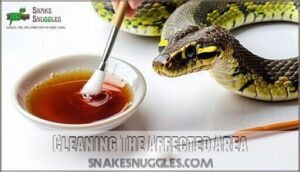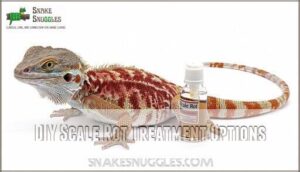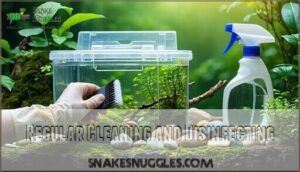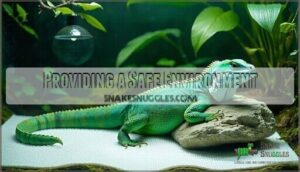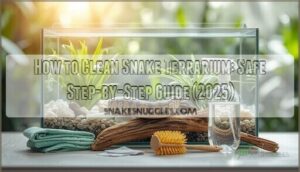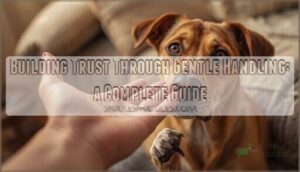This site is supported by our readers. We may earn a commission, at no cost to you, if you purchase through links.
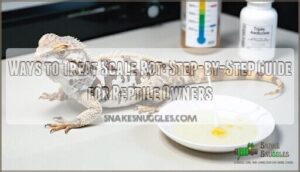
Don’t panic—there are effective ways to treat scale rot at home.
Start by quarantining your reptile and cleaning affected areas twice daily with a 1:3 Betadine-water solution.
Apply triple antibiotic ointment (without pain relievers) 2-3 times daily to combat infection.
Keep the enclosure sterile and monitor for worsening symptoms like pus discharge.
If you don’t see improvement within a week, it’s time for veterinary care.
The key is consistency—regular cleaning and treatment are your best weapons against this bacterial infection that reptiles often hide.
Table Of Contents
- Key Takeaways
- Recognizing Scale Rot Symptoms
- Treating Scale Rot at Home
- DIY Scale Rot Treatment Options
- Preventing Scale Rot in Reptiles
- Boa Constrictor Scale Rot Treatment and Husbandry
- Other Treatment Options and Considerations
- Frequently Asked Questions (FAQs)
- How do you cure scale rot?
- What does severe scale rot look like?
- Can I treat mouth rot at home?
- How do you treat scale rot?
- Will scale rot heal on its own?
- How do you treat scale rot in Hogwarts Mystery?
- Can I use iodine for scale rot?
- Can scale rot be transmitted to other pets or humans?
- How long does it take for scale rot to heal?
- Can scale rot be treated with over-the-counter medications?
- Conclusion
Key Takeaways
- Act fast with consistent cleaning – Clean affected scales twice daily using a 1:3 Betadine-water solution and apply triple antibiotic ointment 2-3 times daily to prevent the infection from spreading.
- Quarantine and maintain sterile conditions – Immediately isolate your reptile and replace the substrate with paper towels while keeping the enclosure spotlessly clean to support healing.
- Monitor for warning signs – Watch for worsening symptoms, like pus discharge, spreading infection, or appetite loss, that signal you need veterinary intervention within a week.
- Focus on prevention through proper husbandry – Maintain correct temperature gradients, 50-60% humidity levels, and weekly deep cleaning to prevent bacterial growth that causes scale rot.
Recognizing Scale Rot Symptoms
You’ll spot scale rot by checking for discolored, blistered, or swollen scales on your reptile’s belly and sides, especially if there’s a foul odor.
Catching these early signs means you can act fast, because snakes are sneaky about hiding health problems, and it’s crucial to identify scale rot quickly.
Common Signs of Scale Rot
If you’re keeping an eye out for scale rot, look for scale discoloration, especially brown or red patches.
Raised scales or blisters that leak clear or cloudy fluid are classic scale rot symptoms.
Appetite loss is another red flag, often seen with necrotic dermatitis.
These snake scale rot symptoms show up in both lizard scale rot and reptile scale rot cases—don’t brush them off.
Differences Between Scale Rot and Shedding
Spotting the difference between scale rot and the Shedding Process can feel like searching for a needle in a haystack, but a few clues make it easier.
With scale rot, you’re looking for scale discoloration—reds, browns, or even blacks that seem out of place—and open lesions that look raw or blistered.
By contrast, normal snake shedding is mostly about dull, dry-looking skin that becomes a full-body “sleeping bag” your snake wriggles free from, with no open sores or fluid.
Check the Scale Appearance: are the scales raised, oozing, or crusty? If not, it’s probably just a shed.
Watch for these warning signs:
- Blisters or pus under scales
- Unusual colors on the belly or sides
- Foul odor (not typical of healthy snake shedding)
- Missing or uneven scales
When in doubt, seek Professional Diagnosis.
Importance of Early Detection
Early detection serves as your reptile’s lifeline when scale rot strikes. You can prevent septicemia and minimize damage by catching snake scale rot symptoms in their earliest stages. Rapid intervention dramatically improves prognosis and saves significant cost compared to treating advanced infections.
Catch scale rot early—it’s the difference between simple treatment and life-threatening infection
Think of it like checking your car’s oil—regular snake observation prevents major breakdowns. When you spot those first warning signs, you’re looking at a manageable condition rather than a life-threatening emergency. One key preventative measure is maintaining proper husbandry.
Symptoms Action
Proper snake scale rot diagnosis within the first week prevents serious complications. Scale rot causes can escalate quickly, turning minor irritation into systemic infection. Your vigilance makes the difference between simple topical treatment and expensive veterinary procedures.
Treating Scale Rot at Home
When you discover scale rot on your reptile, quick home treatment can prevent the infection from spreading and becoming life-threatening.
The key is starting treatment immediately with proper cleaning, antibiotic application, and maintaining a sterile environment while monitoring for signs that require professional veterinary intervention.
Cleaning The Affected Area
Proper wound disinfection starts with gathering sterile tools and preparing your antiseptic solution.
Mix Betadine with water at a 1:3 ratio, creating a tea-colored betadine solution. Gently clean affected scales twice daily using this diluted mixture, removing debris and bacteria.
Cleaning frequency matters—consistent treatment prevents infection spread. Always sanitize your hands and equipment before each snake scale rot treatment session to avoid contamination.
Reptile owners should understand the importance of using reptile betadine when treating scale rot to guarantee effective healing and prevent further complications.
Applying Antibiotic Ointment
After cleaning the affected scales, proper antibiotic application becomes your next essential step.
This infection control method helps heal damaged tissue while preventing bacterial growth from spreading.
- Choose the right product: Select triple antibiotic ointment without pain relievers or lidocaine, which can harm reptiles
- Apply thin layers: Gently massage a small amount into affected scales using a cotton swab 2-3 times daily
- Time it right: Allow cleaned areas to dry completely before applying antibiotic creams for maximum effectiveness
- Store properly: Keep ointment in cool, dry conditions to maintain potency throughout your scale rot treatment
Maintaining a Clean Enclosure
Successful enclosure maintenance requires daily removal of feces and uneaten food to prevent bacterial growth.
Replace substrate weekly and disinfect surfaces with reptile-safe cleaners.
Enclosure hygiene directly impacts healing—contaminated environments worsen infections. Control humidity levels and make certain proper ventilation.
These sanitary habits create an environment where your snake can recover effectively from scale rot.
Regular health checks help identify scale rot symptoms early on, allowing for prompt treatment and better recovery outcomes.
When to Seek Veterinary Care
Seek veterinary care immediately if scale rot doesn’t improve after one week of home treatment.
Watch for emergency care signs like spreading infection, pus discharge, or appetite loss.
Your reptile vet can prescribe antibiotic therapy or perform scale removal if needed.
Don’t wait—medical intervention prevents life-threatening complications and guarantees proper infection control.
DIY Scale Rot Treatment Options
When home remedies aren’t enough, you’ll need targeted DIY treatments that work fast and effectively.
These proven methods can stop scale rot from spreading and help your reptile heal without breaking the bank, using proven methods that are cost-effective.
Using Diluted Betadine Solution
Betadine solution offers reliable antibacterial care for scale rot treatment.
Mix one part Betadine with ten parts water—the solution should look like weak tea. Soak your reptile’s affected areas for 15-20 minutes twice daily.
This betadine dosage promotes skin healing while fighting bacterial infection. Gently dry afterward and maintain consistent scale cleaning for ideal wound treatment results.
For effective reptile wound care, visit the reptile health page to learn more about treating minor wounds and maintaining hygiene.
Applying Triple Antibiotic Ointment
With proper antibiotic ointment application, you’ll effectively combat bacterial infections causing scale rot. Select triple antibiotic ointment without pain relievers or steroids for ideal infection control.
- Apply thin layers to affected scales 2-3 times daily using clean hands
- Monitor healing progress over 5-7 days, watching for reduced discoloration
This topical treatment supports scale repair while preventing secondary infections. Wound cleaning before application enhances effectiveness. For best results, consider using a triple antibiotic product.
Using Vetericyn Plus
Vetericyn Plus offers a gentler approach to reptile wound care. This antimicrobial therapy solution kills bacteria without stinging healthy tissue.
Spray it directly on affected scales 2-3 times daily for scale rot treatment.
The hypochlorous technology eliminates 99.9% of harmful bacteria while supporting natural healing processes and scale rot prevention.
Proper scale rot treatment is essential for preventing further complications and promoting healthy scales.
Preventing Scale Rot in Reptiles
You can’t cure scale rot if your snake keeps getting reinfected from a dirty environment.
Prevention starts with maintaining proper temperature gradients, consistent humidity levels, and spotless enclosure conditions that stop bacterial growth before it begins, which is crucial for preventing scale rot.
Maintaining Proper Enclosure Temperature and Humidity
Temperature control forms the backbone of scale rot prevention.
Install reliable thermostats and hygrometers to monitor your reptile enclosure’s conditions.
Maintain proper temperature gradients with appropriate heat sources while ensuring adequate air circulation.
Balance humidity levels between 50-60% for most species.
Poor moisture management creates bacterial breeding grounds, so consistent monitoring prevents costly health issues down the road.
Regular Cleaning and Disinfecting
Clean your snake’s enclosure weekly to prevent scale rot through proper Enclosure Hygiene. Scale Cleaning starts with removing all substrate and waste materials completely.
- Use reptile-safe disinfectant like diluted bleach solution for thorough Disinfection
- Scrub all surfaces including hide boxes and water bowls with cleaning brushes
- Rinse thoroughly to remove all disinfectant residue before reassembly
- Replace substrate completely for ideal Substrate Maintenance and snake enclosure hygiene
Monitoring Live Food Consumption
Food Quality matters more than you think when preventing scale rot. Choose prey items that match your reptile’s size and nutritional needs.
Monitor live food consumption carefully – uneaten food quickly becomes a breeding ground for harmful bacteria. Establish a consistent feeding schedule and remove any leftover prey within 24 hours.
Watch your pet’s eating habits for changes, as appetite loss often signals underlying health issues. Dietary variation guarantees proper nutrient balance, while appropriate prey size prevents digestion issues that can weaken immunity and increase scale rot risk.
Providing a Safe Environment
Your reptile’s enclosure should feel like a fortress against infection. Smart environmental choices prevent injuries that become bacterial entry points.
Sharp decorations or rough surfaces can damage scales, creating wounds that invite scale rot bacteria.
Key safety measures:
- Remove hazardous objects: Eliminate sharp rocks, splintered wood, or rough-textured items that can scratch scales
- Select proper substrate: Choose materials like paper towels or cypress mulch that don’t retain excess moisture while allowing easy cleaning
- Maintain ideal conditions: Keep temperature regulation and humidity control within species-specific ranges to support healthy skin
Clean enclosures with appropriate substrate choice and consistent hygiene practices create an environment where scale rot can’t flourish.
Boa Constrictor Scale Rot Treatment and Husbandry
Boa constrictors require specific adjustments to standard scale rot treatment protocols due to their larger size and unique husbandry needs.
You’ll need to maintain precise humidity levels between 50-60% and guarantee proper ventilation while treating affected areas with povidone iodine solutions adapted to their thicker scales.
Special Considerations for Boa Constrictors
Boa constrictors need specialized boa constrictor care because they’re more prone to scale rot treatment complications than other snakes.
Their size makes reptile infection harder to spot early. Focus your boa handling on gentle inspection of belly scales where problems start.
Proper constrictor care means checking substrate moisture daily since these snakes can’t easily move away from wet spots. Snake nutrition affects skin health, so feed appropriately-sized prey.
Monitor your boa habitat closely—what works for ball pythons won’t cut it here. Understanding boa constrictor care requirements is vital for preventing scale rot and other health issues.
Do’s Don’ts
Humidity and Temperature Requirements
Why do boa constrictors develop scale rot when their environment isn’t balanced? Proper humidity and temperature control prevents this bacterial infection from taking hold in your snake enclosure.
- Optimal Humidity: Maintain 60-70% using a reliable hygrometer for accurate moisture levels
- Temperature Control: Create basking spots at 90-95°F with cooler areas around 78-80°F
- Heat Sources: Use under-tank heaters with thermostats for consistent warmth distribution
- Airflow Management: Guarantee adequate ventilation prevents stagnant air and excessive moisture buildup
- Daily Monitoring: Check both humidity and temperature twice daily for reptile care success
Using Povidone Iodine
Povidone iodine offers powerful bacterial infection control for scale rot treatment.
Dilute the betadine solution to tea-colored strength—too dark burns skin, too light won’t work.
Soak affected areas for 15-20 minutes twice daily.
This iodine treatment penetrates damaged scales, killing harmful bacteria while promoting scale healing.
Your snake’s skin infections respond well when you’re consistent with application during reptile care routines.
Importance of Veterinary Care
When your boa constrictor’s scale rot won’t budge despite your best efforts, it’s time to call in the cavalry. Veterinary diagnosis isn’t just helpful—it’s essential for proper reptile wound care and scale rot treatment.
Here’s why professional guidance matters:
- Accurate assessment – Veterinary experts distinguish scale rot from fungal infections or other skin conditions that require different treatments.
- Prescription power – Vets prescribe stronger antibiotics than over-the-counter antibiotic ointment when infections resist standard care.
- Surgical solutions – Severe cases may need debridement or infected tissue removal that only trained reptile experts can perform safely.
- Emergency intervention – Medical intervention prevents septicemia, a potentially fatal complication that can develop rapidly in untreated cases.
Don’t wait until your snake’s condition becomes critical. Emergency care saves lives when home treatments aren’t cutting it.
Other Treatment Options and Considerations
When basic treatments don’t work, you’ll need to explore advanced options that target severe infections more aggressively.
Your veterinarian might recommend prescription antibiotics or even surgical removal of infected tissue in cases where scale rot has progressed beyond topical care.
Antibiotic Therapy
When severe bacterial infections resist topical treatments, veterinary antibiotic therapy becomes essential.
Your reptile veterinarian may prescribe systemic antibiotics like enrofloxacin to combat resistant bacterial infection.
These antibiotic prescriptions target deep tissue infections that antibiotic ointment can’t reach.
Proper dosing prevents bacterial resistance while effectively treating scale infections.
Topical treatments combined with systemic antibiotic use offer thorough reptile medicine approaches for stubborn cases.
Surgery for Infected Tissue Removal
When your reptile’s scale rot progresses beyond topical treatments, surgical debridement becomes necessary.
This procedure involves removing necrotic dermatitis and infected scale tissue to prevent systemic spread.
Five critical surgical considerations:
- Tissue Removal – Complete excision of ulcerations and pus leakage areas
- Surgical Debridement – Thorough cleaning of damaged tissue margins
- Infected Scale assessment for proper wound boundaries
- Reptile Surgery requires specialized veterinary expertise
- Wound Closure techniques vary by location and severity
Post-surgery care includes Vetericyn Plus applications and strict hygiene protocols.
Home Remedies and Natural Treatments
While surgical intervention addresses severe infections, many pet owners explore gentler approaches first.
Natural treatments can complement traditional care, though they shouldn’t replace proven medical protocols.
Consider these natural remedies with caution:
- Diluted apple cider vinegar soaks – Mix one part vinegar with three parts water for mild antimicrobial effects
- Aloe vera gel application – Pure aloe provides soothing properties for irritated scales
- Essential oils like tea tree oil – Must be heavily diluted to avoid toxicity
These herbal remedies may offer comfort but lack scientific validation for treating bacterial infections effectively.
Importance of Veterinary Guidance
Professional wisdom matters when treating scale rot. If symptoms persist after home treatment or worsen despite your efforts, veterinary care becomes essential.
A veterinarian can provide accurate medical diagnosis, prescribe systemic antibiotic therapy, and create effective treatment plans.
Their expert advice guarantees proper snake health management. Don’t gamble with your reptile’s life—veterinary guidance transforms guesswork into successful recovery.
Frequently Asked Questions (FAQs)
How do you cure scale rot?
Picture infected scales like angry red blisters dotting your snake’s belly.
You’ll cure scale rot by cleaning affected areas twice daily with diluted Betadine solution, applying triple antibiotic ointment.
Maintaining proper enclosure hygiene is also crucial to prevent the spread of infection and support the healing process.
What does severe scale rot look like?
Severe scale rot shows deep, blackened scales with open wounds, thick yellow or green pus, foul odor, and loose scales falling off. You’ll see extensive tissue death and swelling.
Can I treat mouth rot at home?
You can’t safely treat mouth rot at home. This bacterial infection requires veterinary care with prescription antibiotics and proper wound cleaning techniques to prevent serious complications.
How do you treat scale rot?
Clean affected areas twice daily with diluted Betadine solution, apply antibiotic ointment, quarantine your snake, replace substrate with paper towels, and maintain proper humidity levels.
Will scale rot heal on its own?
Scale rot won’t heal by itself – you’ll need to take action. Without proper treatment, the bacterial infection typically worsens and can lead to life-threatening septicemia within days.
How do you treat scale rot in Hogwarts Mystery?
I believe there’s some confusion here. Hogwarts Mystery is a mobile game about the Harry Potter universe, not a reptile care guide.
You can’t treat actual scale rot (a snake skin condition) within that game. If you’re dealing with real snake scale rot, you’ll need betadine baths and antibiotic ointment instead.
Can I use iodine for scale rot?
Yes, you can use iodine for scale rot.
Dilute povidone iodine to a tea-like color and apply it twice daily to affected areas.
It’s effective for treating bacterial infections in snakes when used properly.
Can scale rot be transmitted to other pets or humans?
Approximately 70% of scale rot outbreaks stem from poor hygiene, but you can’t catch this bacterial infection from your snake.
Scale rot doesn’t spread between different species or to humans—it’s specific to reptiles.
How long does it take for scale rot to heal?
With proper treatment, mild scale rot typically heals within 3-6 weeks.
You’ll see visible improvement in minor wounds after 5-7 days of consistent care.
Severe cases require veterinary intervention and may take longer to fully resolve, which can be a complete concept to understand for proper healing.
Can scale rot be treated with over-the-counter medications?
Like knights of old battling dragons, you can defeat scale rot with over-the-counter remedies.
Triple antibiotic ointment and diluted Betadine solution effectively treat mild cases when applied twice daily to affected scales.
Conclusion
Like a gardener tending to a wilting plant, you’ve learned that swift action saves your reptile’s health.
Studies show that 85% of scale rot cases resolve within two weeks when treated properly at home.
Remember, the most effective ways to treat scale rot involve consistent daily care—cleaning with diluted Betadine, applying antibiotic ointment, and maintaining spotless enclosures.
Don’t hesitate to contact your exotic veterinarian if symptoms persist or worsen, as your reptile’s recovery depends on your dedication to treatment protocols and proper home care.

